Google Pixel 8 Pro — 6 reasons to buy and 3 reasons to skip
The Pixel 8 Pro has a lot of strong features, but there are also reasons to hold off on buying
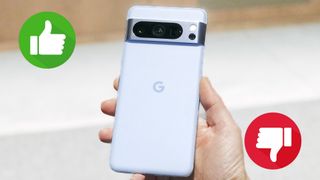
There's no mistaking the Google Pixel 8 Pro as anything other than Google's premium flagship phone. It's got the big screen, dedicated telephoto lens and high-end look that helps it fit in with the best phones from other device makers. And now that the Pixel 8 costs more, it's got the premium price tag, too.
Now that Google's Pro phone starts at $1,000, does it still deliver good value? After some Pixel 8 Pro hands-on time, we can certainly make that case, thanks to all the improvements Google has introduced. From better cameras to more extensive use of AI, there's a lot to like about the Pixel 8 Pro, plus there's a brighter display and new Tensor G3 chip.
Not everyone is going to find those changes to be worth the $100 premium Google is charging over the Pixel 7 Pro. To find out where you fall on the Pixel 8 Pro spectrum, check out our reasons for buying this phone versus some of the downsides we've spotted in our initial time with Google's latest device.
Google Pixel 8 Pro: Reasons to buy
Every rear camera is better
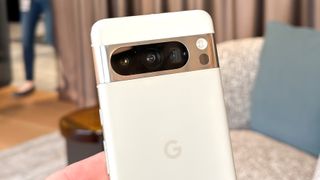
Updating any of the cameras on the Pixel 8 Pro would have been a step forward. Google updated all three of the rear cameras, which should help put the Pixel 8 Pro right in the mix of the best camera phone competition.
The main rear camera on the Pixel 8 Pro still uses a 50MP sensor, but there's a wider aperture aimed at improving low-light performance. The same thing goes with the telephoto lens, which also promises brighter shots. Finally, Google upgraded the ultrawide lens, which went from a 12MP sensor on the Pixel 7 Pro to a 48MP shooter on the new phone. Even better, you can use the ultrawide lens to take macro shots.
The end result should be brighter, more detailed photos, with the output from the Pixel 8 Pro able to go up against the best shots that the iPhone 15 Pro Max and Galaxy S23 Ultra have to offer.
Pro-specific camera features
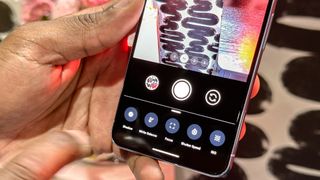
The same AI-powered photo processing and editing improvements that are part of the Pixel 8 also come to the Pixel 8 Pro. We're talking about Magic Editor, where you can tweak lighting, shot composition and other details about a photo to wind up with the perfect shot. Best Take lets you mix and match faces from different group shots so that your finished photo has everyone looking their best. And Audio Magic Eraser promises to be great at removing unwanted sounds from the video footage you capture with your Pixel
But there are also smart photo features specific to the Pixel 8 Pro. The Magic Eraser feature gets a boost that allows it to erase larger objects and areas without leaving artifacts and smudges behind. And before the end of the year, Pixel 8 Pro owners will have access to a Video Boost feature that lets them upload RAW video footage to the cloud for adjustments to color, lighting, graininess and stabilization. These are the sorts of features that make the Pixel 8 Pro ideal for anyone who's serious about digital photography and video.
A new temperature sensor
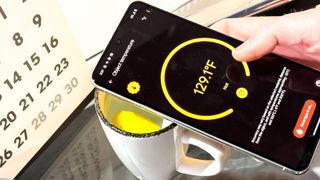
Maybe you weren't crying out for this feature, but the Pixel 8 Pro has an exclusive temperature sensor. And gimmicky though it may be right now, there's some potential for this sensor to be useful down the road.
Right now, the temperature sensor can detect how hot and cold objects are — useful if you want to check on the temperature of foods, liquids and the occasional surface, but potentially just a cool party trick for many users. However, Google is working with the U.S. Food and Drug Administration to get the Pixel 8 Pro's sensor approved for taking the temperatures of people. That could be a very helpful feature, letting you do a quick temperature spot check on a child to see if they need to stay home from school with a fever.
A better Tensor G3 chip
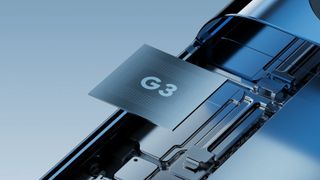
For the Tensor G3 powering the Pixel 8 Pro, Google upgraded the GPU and turned to the latest CPUs from ARM. Whether that closes the performance gap between Google's Tensor silicon and chipsets like the Snapdragon 8 Gen 2 won't be known until we can run some benchmarks. But regardless of how that turns out, the improvements to this chipset's Tensor Processing Unit sound like they're worth the price of admission.
According to Google, the Tensor G3's TPU can run more than double the number of machine learning models than the Tensor inside the Pixel 6, and it can do that on device. That's how the Pixel 8 Pro can offer some of the photo features detailed above like Magic Eraser's ability to remove larger objects. But it also enables some other unique features on the phone.
The Call Assist feature on board the Pixel 8 Pro has a more realistic-sounding assistant fielding incoming calls, and it's smart enough to flash an on-screen message as to what the call's about. You'll be able to speak to the Google Assistant on board the Pixel 8 Pro in a more natural way — don't worry about pauses and "ums" confusing the assistant — and the Google Assistant can now read webpages back to you. Soon, you'll even be able to push a button in the recorder app to get an on-the-fly summary of the content of what you've recorded.
These are some pretty impressive capabilities that would have been unthinkable not long ago, and the Tensor G3 should be able to pull them off without a sweat.
A brighter display
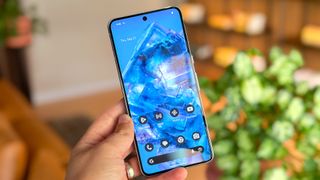
At 927 nits, the Pixel 7 Pro's 6.7-inch display offered decent brightness, but it fell far short of the results produced by comparably sized phones like the Galaxy S23 Plus (1,345 nits) and iPhone 15 Pro Max (1,550 nits) when we broke out our light meter. Google hopes to improve things by turning to a brighter panel for the Pixel 8 Pro.
Specifically, Google's new phone features a Super Actua display, which promises quite a boost in brightness — 1,600 nits for HDR brightness with a peak of 2,400 nits.
In practice, displays rarely reach those listed maximums. But if the Super Actua display gets anywhere in the same ballpark as those numbers, it's going to outshine phones from Apple and Samsung by some measure.
A new matte finish
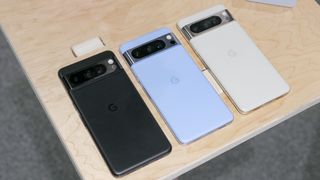
At first glance, the Pixel 8 Pro doesn't look all that different from the Pixel 7 Pro. And really, there aren't too many noteworthy design changes — save for one.
The Pixel 8 Pro offers a matte glass finish, and my colleague John Velasco reports that the it helps the phone feel especially grippy when you're holding it. If you haven't cared for the slick of previous Pixel Pros, it sounds like this new model is going to be a lot easier to hold on to.
Google Pixel 8 Pro: Reasons to skip
You're paying more for this year's Pro model
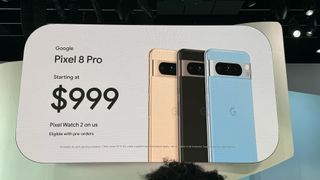
Both Pixel 8 models are getting a $100 price hike from the previous generation, which puts the regular Pixel 8 at $699 while the Pixel 8 Pro now costs $999. At least the standard Pixel is still cheaper than the competition — the Pixel 8 Pro now costs as much as the iPhone 15 Pro and Galaxy S23 Plus, eliminating Google's price advantage.
Individual shoppers will ultimately have to decide whether the Pixel 8 Pro vs. Pixel 7 Pro differences are significant enough to justify the added expense. After some initial time with the Pixel 8 Pro, I think the changes are noteworthy enough. But if one of the things you liked about the Pixel was how much less it cost relative to other top phones, the Pixel 8 Pro can no longer make that claim.
Is the battery life any better?
A missing piece of the Pixel 8 Pro puzzle is how long it can last on a charge. Our fervent hope is "much longer than the Pixel 7 Pro" since that phone barely lasted more than 8 hours on our test. The average smartphone gets closer to 10 hours of continuous web surfing before it runs out of power, and the devices on our best phone battery life list last 11.5 hours or longer.
Unfortunately, Google hasn't offered much guidance on what to expect from the Pixel 8 Pro's battery life. We know the Pixel 8 Pro has a larger battery than the Pixel 7 Pro (but only slightly), and it's possible the Tensor G3 does a better job with power management. But until we know for certain, questions over battery life could be enough to keep us from fully embracing the Pixel 8 Pro.
Limited storage in the base model

Samsung has figured out that high-end phones need greater amounts of storage, as both the Galaxy S23 Plus and S23 Ultra start with 246GB of storage. The iPhone 15 Pro Max also starts with 256GB at a minimum.
Whatever lesson these other phone makers learned has eluded Google, which continues to offer just 128GB of storage in its base model. That's a paltry amount for any phone with Pro in its name, but it's especially skimpy when one of the marquee features of that device is how well it captures photos and video.
It's not difficult to figure out why Google — a company with a thriving side business offering cloud storage — might not see the merits of offering too much physical storage. But it's something that the pro users Google hopes to attract would certainly appreciate. And it might be another step toward accepting that higher price tag for the phone.
Google Pixel 8 Pro outlook
There's a lot to like about the Pixel 8 Pro, particularly when it comes to the phone's cameras. The bigest sticking points with the phone at this point are its $999 cost and the uncertainty over how long it will last on a charge. Pixel 8 Pro preorder deals can help address the formal, while our testing should fill in a lot of the details about just how good this phone can be.
More from Tom's Guide
Sign up to get the BEST of Tom’s Guide direct to your inbox.
Upgrade your life with a daily dose of the biggest tech news, lifestyle hacks and our curated analysis. Be the first to know about cutting-edge gadgets and the hottest deals.
Philip Michaels is a Managing Editor at Tom's Guide. He's been covering personal technology since 1999 and was in the building when Steve Jobs showed off the iPhone for the first time. He's been evaluating smartphones since that first iPhone debuted in 2007, and he's been following phone carriers and smartphone plans since 2015. He has strong opinions about Apple, the Oakland Athletics, old movies and proper butchery techniques. Follow him at @PhilipMichaels.
-
rflashman Article doesn't address the biggest challenge with the 7 Pro, how it overheats in sunlight and the screen goes dim and dimmer until you can barely see it. Only reason I won't upgrade is no one can confirm if the 8 fixes this. I ride a motorcycle and go to the beach a lot, both situations where my phone is exposed to sunlight. Having an unreadable dark display due to sunlight is not very useful.Reply

